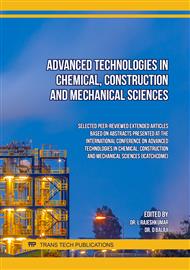[1]
Fadare, D.A., Fadara, T.G., and Akanbi, O.Y.. Effect of heat treatment on mechanical properties and microstructure of NST 37-2 steel.Journal of Minerals & Materials Characterization & Engineering. 10 (2011)299–308.
DOI: 10.4236/jmmce.2011.103020
Google Scholar
[2]
OskariHaiko, AnttiKaijalainen, SakariPallaspuro, JaakkoHannula, David Porter, TommiLiimatainen and JukkaKomi.. The effect of tempering on the microstructure and mechanical properties of a novel 0.4C press-hardening steel. Applied Sciences. 9(2019)1–16.
Google Scholar
[3]
Sephton,M., and Pistorius, P.C. 1997. Strengthening of a cold worked 17% Cr ferritic stainless steel (type 430) by heat treatment. The Journal of the South African Institute of Mining and Metallurgy. (1997) 185–192.
Google Scholar
[4]
Lin, W. P., Fan, Y. J., Zhang, Z. L., Zhu, J. W., & Liu, Y. N.. Microstructure and mechanical properties of a ultra-high carbon steel. Key Engineering Materials. 324 (2006) pp.907-910. Trans Tech Publications Ltd.
DOI: 10.4028/www.scientific.net/kem.324-325.907
Google Scholar
[5]
Xingang Tao, Chuanwei Li, Lizhan Han and JianfengGu.. Microstructure evolution and mechanical properties of X12CrMoWVNbN10-1-1 steel during quenching and tempering process. Journal of Materials Research and Technology, 5(2016)45–57. http://dx.doi.org/10.1016/j.jmrt. 2015.06.001.
DOI: 10.1016/j.jmrt.2015.06.001
Google Scholar
[6]
Abin BABURAJ, Shishupal Singh CHAUDHARY, K.B., Rajesh KHATIRKAR, K., and Sanjay SAPATE, G.. Abrasive wear behaviour of heat treated En31 steel. ISIJ International. 53 (2013)1471–1478. DOI: http://dx.doi.org/10.2355/isijinternational.53.1471.
DOI: 10.2355/isijinternational.53.1471
Google Scholar
[7]
Cori Natoli and Steve Oimoen. 2019. Classical designs: Full factorial designs. Report no. STAT COE-35-2018, Scientific Test & Analysis Techniques Center of Excellence. 2950 Hobson Way-Wright-Patterson AFB,OH45433.
Google Scholar
[8]
Jayaraman, P., and Mahesh kumar, L.,. Multi-response optimization of machining parameters of turning AA6063 T6 aluminium alloy using grey relational analysis in Taguchi method. Procedei Engineering. 97 (2014) 194–204.
DOI: 10.1016/j.proeng.2014.12.242
Google Scholar
[9]
Ashvin Makadia, J., and Nanavati, J.I.,. Optimization of machining parameters for turning operations based on response surface methodology, Measurement. 46 (2013) 1521–1529. http://dx.doi.org/10.1016/j.measurement.2012.11.026.
DOI: 10.1016/j.measurement.2012.11.026
Google Scholar
[10]
Harsimran Singh Sodhi,.Optimization of Cnc turning parameters for Al-6061 using response surface methodology. International Journal of Operations Research. 20 (2017) 180–206.
Google Scholar
[11]
Sankha Bhattacharya. Central composite design for response surface methodology and its applications in pharmacy.Response surface methodology in Engineering, Intechopen, (2021) 1–19. DOI: http://dx.doi.org/10.5772/intechopen.95835.
DOI: 10.5772/intechopen.95835
Google Scholar
[12]
Teimouri, S., Mawire, G., Potgieter, J.H., Simate, G.S., van Dyk, L., and Dworzanowski, M. Using experimental design and response surface methodology (RSM) to optimize gold extraction from refractory sulphidic gold tailings with ionic liquids. The Journal of the southern African Institute of mining and Metallurgy. 120 (2020) 415–423. DOI ID: http://dx.doi.org/10.17159/2411- 9717/1068/(2020).
DOI: 10.17159/2411-9717/1068/2020
Google Scholar
[13]
Nasir, S.M., Ismail, K.A., Shayfull, Z. and Shuaib, N.A.. Comparison between single and multi gates for minimization of war page using Taguchi method in injection molding process for ABS material, 594, pp.842-851. Trans Tech Publications Ltd. (2014).
DOI: 10.4028/www.scientific.net/kem.594-595.842
Google Scholar
[14]
Şahin, Y. and Yalcinkaya, S. Application of Taguchi Technique to Surface-Grinding of Mold Steel. In Key Engineering Materials 689, pp.7-11. Trans Tech Publications Ltd. (2016).
DOI: 10.4028/www.scientific.net/kem.689.7
Google Scholar



